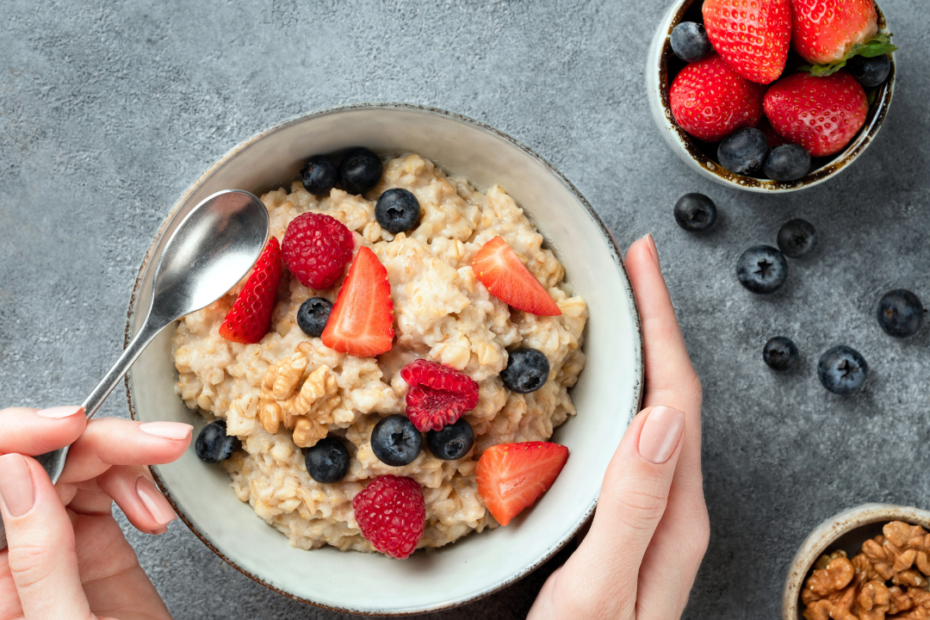Fiber has many health benefits. It can help reduce cholesterol, support a healthy gut, lower the risk of developing colorectal cancer, stroke, coronary heart disease and type 2 diabetes. However, many of us are missing out on these benefits because we don’t get enough in our diet. The average American gets about 15 grams a day – that’s about half the recommendation. Fiber is an essential part of a healthy diet and is something we shouldn’t be scrimping on. To see how your daily fiber intake stacks up, take this quiz. But first, a primer on fiber.
What is fiber? Fiber is a specific type of carbohydrate that is found only in plant-based foods such as fruit, vegetables, legumes, nuts and seeds. The thing that makes fiber different from other types of carbohydrates like starch or sugar, is that it is indigestible to humans, because we lack the digestive enzymes needed to break it down. Therefore, the calories absorbed from fiber are negligible.
There are two types of fiber: soluble fiber & insoluble fiber
Soluble fiber acts like a sponge in the digestive tract. Soluble fiber binds with cholesterol and removes it from the bloodstream.
– It can lower blood sugar because it slows down how fast food is digested. This is especially important if you have diabetes
– It may help firm stool and reduce diarrhea
– Food sources of insoluble fiber include oats, oat bran, barley, wheat bran, popcorn, dried beans and peas, carrots, bell peppers, raspberries, blueberries, strawberries, and apples
Insoluble fiber passes through the intestinal tract quickly
– It can prevent constipation
– It can prevent infections of the gut
– It can also prevent heart disease, and may prevent some types of cancer
– Food sources of insoluble fiber include fruits with skins, asparagus, Brussels sprouts, broccoli, prunes, oranges, grapefruit, nuts, legumes, bran, and brown rice
Fiber can also aid in weight management because it helps you to feel fuller longer. This can help prevent frequent hunger pangs and overeating. High fiber foods take longer to chew, so this may help a person eat slower.
How much fiber is recommended?
The Academy of Nutrition and Dietetics (AND) recommends eating between 25 and 35 grams of fiber per day for adults. However, the average person eats about 12-15 grams of fiber per day.
If you are including more fiber in your diet, you should start slowly, adding a few grams to each meal while working your way up to the recommendation. Also be sure to drink 6-8 cups of water a day as you increase your fiber intake. Fiber absorbs water in the GI tract and drinking water will help prevent gas, bloating and constipation. To determine if you are meeting your daily fiber needs, think about what you ate yesterday and calculate your intake with this quick quiz:
1) Multiply number of servings of fruit and vegetables per day by 1.5 grams of fiber
Example: 5 servings x 1.5 = 7.5 grams of fiber
Yesterday, I had __ servings x 1.5 = __ grams of fiber from fruits and vegetables
2) Multiply number of servings of refined grains by 1.0 grams of fiber. Refined grains include white flour, white bread, white rice or pasta and cereals such as corn flakes, special K, and frosted flakes.
Example: 4 servings x 1.0 = 4 grams of fiber
Yesterday, I had __ servings x 1.0 grams of fiber = __ grams of fiber from refined grains
3) Multiply number of servings of whole grains by 2.5 grams of fiber. Whole grains are whole wheat bread, whole wheat flour, brown rice, and whole wheat pasta.
Example 3 servings x 2.5 = 7.5 grams of fiber
Yesterday, I had __ servings x 2.5 grams of fiber = __ grams of fiber from whole grains
4) Multiply number of servings of high fiber foods by 5 grams of fiber. High fiber foods may include beans or high fiber cereal.
Example: ½ cup of black beans or 1 serving high fiber cereal x 5 grams = 5 grams
Yesterday, I had __ servings x 5 grams of fiber = __ grams of fiber from high fiber foods
Add up your total grams of fiber from each category. This is the estimate of how many grams of fiber you are getting per day
Content submitted by Janyce Gately – MS, RD, LDN, CHWC
Take the guesswork out of healthy eating by working with a registered dietitian. Set realistic goals, create an action plan, get started off on the right foot and receive guidance along the way. Reach out to the dietitians at Waverley Oaks to learn more at nutrition@waverleyoaks.com.
